The Samsung Galaxy Note 4 Review
by Joshua Ho on October 15, 2014 9:00 AM EST- Posted in
- Smartphones
- Samsung
- Android
- Mobile
- Galaxy Note 4
Battery Life
Battery life is one of the most important aspects of any mobile device, especially because the battery is what defines mobility to begin with. As a result, it’s important to test battery life in a meaningful manner. This requires a repeatable test with standardized conditions, and a range of scenarios that stress different aspects to get the full picture. Most importantly, for tests that have the display on we calibrate the display to 200 nits to ensure that the test doesn’t penalize brighter displays. In the case of the Galaxy Note 4, we see about a 3% gain in battery capacity, so most of the battery life gains should come from higher efficiency.
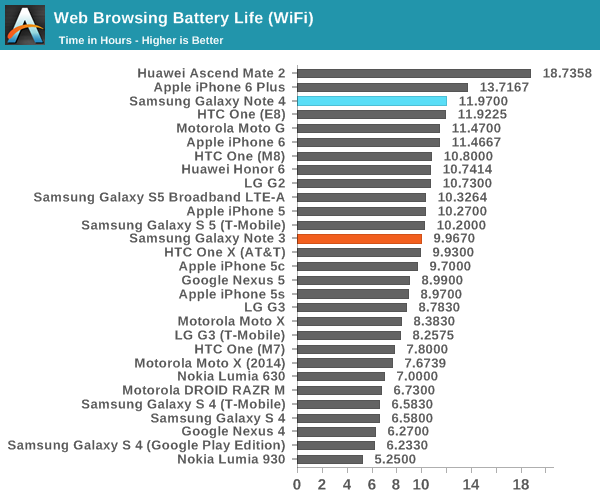
Our first test is the WiFi web browsing test, which loads a given set of web pages in a loop, with special emphasis taken in order to ensure that the test doesn’t penalize faster SoCs, which would have significant effects on our results. As one can see above, the Galaxy Note 4 has a noticeable uplift in battery life when compared to the Galaxy S5 and lasts significantly longer than the Galaxy Note 3. It doesn’t last quite as long as the iPhone 6 Plus, but few people should have issues getting through a full day of intensive use.
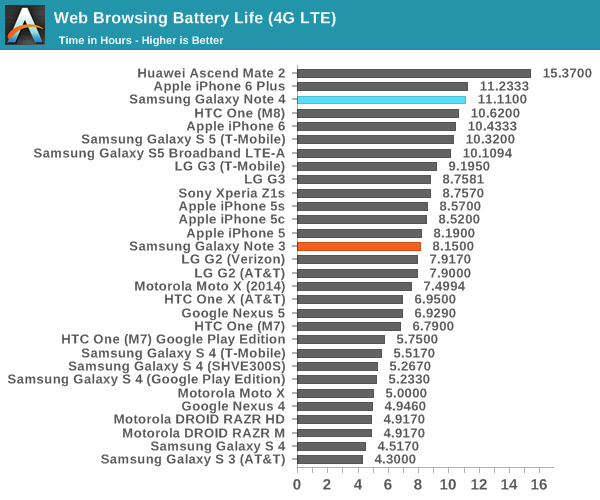
On LTE web browsing, a similar story plays out as the Galaxy Note 4 is able to keep up with the competition and delivers the massive improvement that we’ve generally seen from the transition to Snapdragon 801 and 805.
While the web tests are well-worn by now, we’ve added two additional tests to the battery life suite in order to get a better picture of SoC-bound battery life. To this end, we use an infinite loop of T-Rex on-screen to replicate a GPU-intensive scenario and Basemark OS II’s battery life test to simulate a CPU-intensive scenario.
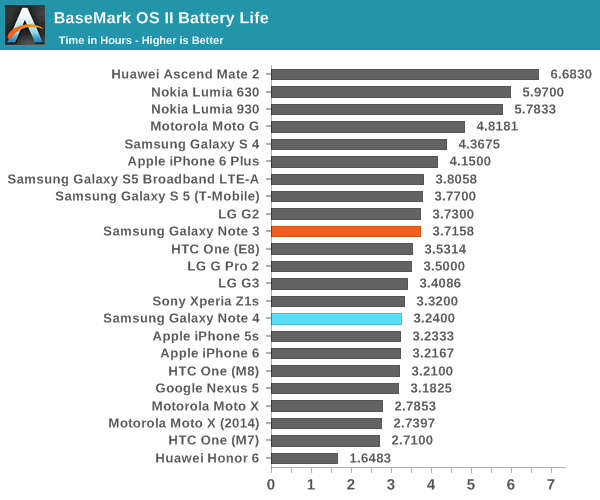
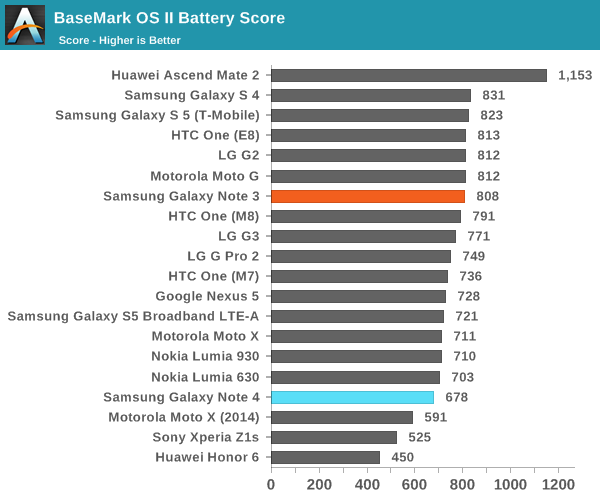
In the case of the Basemark OS II test, we see that battery life under a sustained task ends up a bit lower than we expect, which seems to suggest that in CPU-bound tasks the Note 4 doesn't have much better efficiency when compared to the Galaxy Note 3. This seems to be self-evident, as the CPUs are quite similar and the process technology used is largely similar when comparing the two devices.
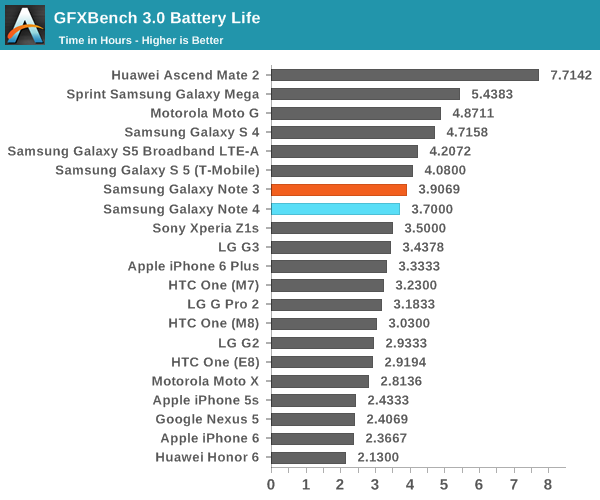
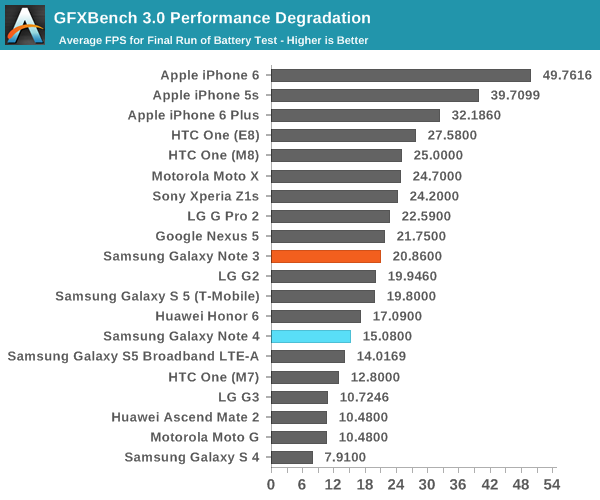
In GFXBench's endless rundown test we see that the Galaxy Note 4 trails behind in battery life when compared to the GS5 LTE-A, but looking at the end of run FPS it’s quite clear that the Galaxy Note 4’s larger surface area makes it possible to achieve greater performance.
Overall, battery life is quite good on the Galaxy Note 4. It’s a massive leap forward when compared to the Galaxy Note 3, but a relatively small one when compared to the Galaxy S5. Once again, we see that most of the benefits in battery life will come from scenarios where power draw isn’t strongly influenced by the display.
Charge Time
As a part of the overall battery life story, it's important to consider the time it takes for a battery to fully charge. If a phone's battery charges slowly then scenarios where charge time becomes crucial will severely hurt real-world battery life. For example, if one forgets to charge their phone at night, the rate at which the phone will charge the battery is a strong influence upon actual battery life. In order to test this, we measure power draw from the time that the device under test is plugged in until it reaches a given level of power draw that indicates that the battery is fully charged.
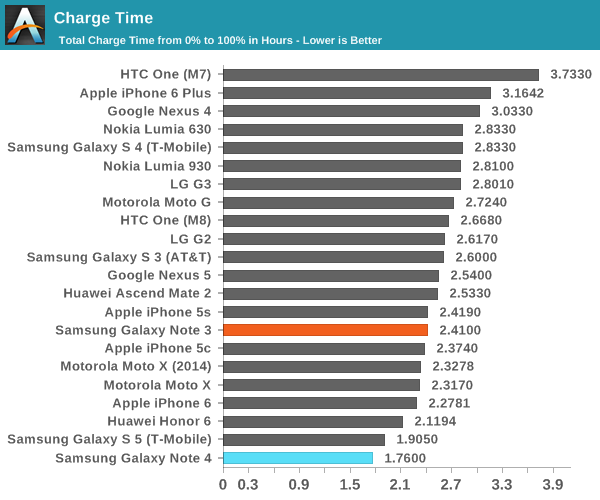
As one can see in the graph above, the adaptive fast-charge mechanism really works, although I don't see a huge benefit when compared to the Galaxy S5's charge time which was already incredibly fast. In the case of the Galaxy Note 4 it seems that it switches between a 9V, 1.64A mode and a 5V, 2A mode as needed, and most of the benefit would come from the first 50% or so of charging as power drops rapidly as the battery approaches full charge.










195 Comments
View All Comments
akdj - Wednesday, November 12, 2014 - link
I'm sure I'm being ignorant here, but how do I 'access' that satellite display?'Best option....the one built into Qualcomm's own modem...'
Is that an option already 'built in' or an app downloaded from the Play Store? I owned the original Note and couldn't get out of it quick ebough! Contract expired, I went in to look for my next dedicated business line (the original Note's responsibilities;)) --- & about thirty seconds with the Note 3 I caved. Bought it and I've enjoyed it daily without issue for almost 14 months now. It's paid off in two, and this review leaves me curious. Especially the display & it's 'relative' efficiency maintained in essentially the same package and by doubling it's resolution.
Something to be said for these sharper, HiDPI displays ...especially for those of us with 'aging eyes' ;) --- I couldn't be happier with this resolution push, and the good riddance to 3D!
Sorry, TL/DR
What is he using as an app for that screenshot in the GPS lock tool?
Thanks
NeatOman - Wednesday, October 15, 2014 - link
Curious to see the difference in battery life between 2.4Ghz Wireless N and Wireless AC, I've noticed a significant increase with my Nexus 5, and of course it was said the rest of the tests will be up later so that's cool.skinygeek - Wednesday, October 15, 2014 - link
No Word about the Exynos Variant? I was expecting a detailed analysis of the Exynos 5433. Was the Exynos version not provided to you for review?Laxaa - Wednesday, October 15, 2014 - link
I think the Exynos variant is the international one. I guess Samsung didn't send them one as it won't be out in the US.skinygeek - Wednesday, October 15, 2014 - link
Then they should have bought it . How hard it is to get an international variant of a device. There are websites which ship you these things. I don't expect such things from other websites, but Exynos 5433 marks a new Chapter in SOC's for Android phones for being the first high end A57+A53 CPU and i was expecting Anandtech to review hat SOC given their expertise in such things .Laxaa - Wednesday, October 15, 2014 - link
Hopefully, a comparison will be made at a later date if they get a hold of such a device. I agree that it will be interesting to see how if fares.extide - Wednesday, October 15, 2014 - link
Even though it's A57/A53 it is still locked down to 32-bit only :(gunsman - Wednesday, October 15, 2014 - link
but it will allow us to better quantify the addition of ARMv8 and 64 bit once ARMv8 enabled A57/A53 comes outKPOM - Wednesday, October 15, 2014 - link
Anandtech is still a U.S.-oriented site. And the 805 will be sold in more markets. There is plenty of data out there on the Exynos' performance. It isn't that good, which is why Samsung used the 805 in its most lucrative markets such as the US, EU, and Japan.heartinpiece - Thursday, October 16, 2014 - link
I disagree with the performance part, Some benchmarks show that the exynos 5433 surpasses the 805. The only reason 805 is used, (as far as I know) is the modem chips.a simple comparison:
805 Geekbench: of note 4
http://browser.primatelabs.com/geekbench3/780401
exynos 5433 geekbench of note4
http://browser.primatelabs.com/geekbench3/775316
Now i don't mean to say this benchmark shows the whole story.
But I am saying that 'it is that better'
Anandtech is a US oriented site, however for first A57+A53 SoC, it is well worth the review.